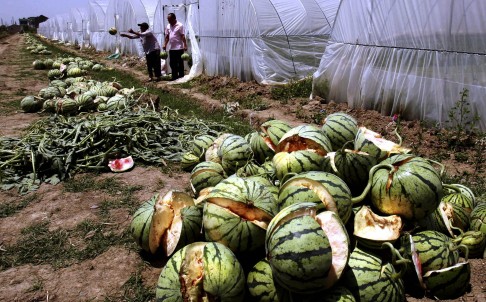China smog blocks sunlight, posing threat to agriculture, warn scientists
Researchers and agricultural firms notice a slowdown in plant growth and rise in sickly plants as air pollution cuts off much-needed sunlight
Farmers clear out damaged watermelons from their rented greenhouse in Jiangsu province. Smog particulates have coated the panels of greenhouses at farms, blocking much-needed sunlight for plants. Photo: AP
Smog in China could block light and will bring disaster to agricultural production, mainland scientists warned.
Already, the choking air conditions – which blanketed one-quarter of the mainland’s land area – have had detrimental effects on agriculture.
He Dongxian, an associate professor with China Agricultural University’s College of Water Resources and Civil Engineering, said on Monday that the school conducted an experiment in Beijing on smog's effect on plants over the last few months and observed a drastic slowdown in photosynthesis, which is the main process that allows plants to survive.
Applied on a larger scale, such slowdowns could spell trouble for China’s agriculture, which contributes some 10 per cent to its GDP.
Farm output would likely be affected by serious air pollution in winter and spring, with the prices of many agricultural products expected to increase this year. There are concerns about food supply: China imported more than 70 million tonnes of food products last year, the largest ever, and the food self-reliance rate was reduced to less than 90 per cent, according to government figures.
[The plants] will be lucky to live at all. Now almost every farm is caught in a smog panic
In He’s tests, chilli and tomato seeds, which normally took about 20 days to grow into full-grown seedlings under artificial light in a laboratory, took more than two months to sprout at a greenhouse farm in Beijing’s Changping district.
Membranes and air pollutants sticking to the greenhouse’s surface cut the amount of light available for the plants by half, He said. Depriving plants of light means photosynthesis – the process by which plants convert carbon dioxide into oxygen and store a type of sugar to sustain its life processes – can hardly be sustained.
Most seedlings in the farm were weak or sick. “They will be lucky to live at all. Now almost every farm is caught in a smog panic,” she said, adding that the poor seedling quality would cut the country’s agricultural output this year.
If the smoggy weather persists or intensifies, China’s food supply would be under a serious threat, He said.
“A large number of representatives of agricultural companies had suddenly showed up in academic meetings on photosynthesis in recent months and sought desperately for solutions,” she said. “Our overseas colleagues were shocked by the phenomenon because in their countries, nothing like this had ever happened.”
Greenhouse farms, which occupy more than four million hectares of land and currently supply most of the mainland’s vegetables, would be the first to be hit by an agricultural crisis.
“Orange” and yellow” smog alerts – among the highest on the scale – remained in Beijing and other cities. The smog shrouded as much as one-fourth of China’s land area and the situation would not improve until Thursday, authorities said.
In the Chinese capital, the US embassy air quality index recorded smog levels of 432 micrograms per cubic metre at noon on Tuesday.
Digging for solutions
Gao Tanggui, a sales manager for the Beijing Shinong Seed Company, said their farms had been severely affected by smog. Their plants were sickly and were growing slowly.
“The impact is definite and serious. Now everyone in the company, from farmers to salespersons, are deeply concerned,” he said.
Agricultural companies are experimenting with countermeasures, including installing expensive and electricity-guzzling artificial lighting, while many farms have dramatically increased the use of plant hormones to stimulate growth, Gao said.
Dr Fu Qiushi, a researcher with the Chinese Academy of Agricultural Sciences’ Institute of Vegetables and Flowers, said making an accurate estimate of smog’s effect on photosynthesis would be difficult due to the limitations of lab simulations.
Even the best artificial light cannot match natural light in all spectrums, adding uncertainty to test results. But “we can’t put two plants in the same area and measure their growth at the same time, with one under smoggy weather and the other blue sky. Such experimental challenges must be overcome to produce convincing results for official estimates”, she said.
Meng Jihua, associate professor with the Chinese Academy of Sciences’ Institute of Remote Sensing and Digital Earth, said scientists in other countries such as the United States had measured the effect of smog on agricultural output, but their models could not be applied directly to China because the smog was quite different from that in London or the US west coast.
He said air pollutants in China could absorb or deflect light with varying mechanisms and efficiency, and new mathematical models were needed, he said.
Chinese scientists had sufficient tools and data from remote sensing satellites to come up with a fairly accurate estimate on smog’s role in agricultural losses.
One challenge was to single out smog from other elements such as the level of rainfall and plant diseases.
With current technology, the estimate could be as accurate as 80 per cent. “Such studies are sensitive and their results will probably not be released to the public,” Meng said.
“Some government officials might worry that linking smog to agricultural production would prompt a panic. But there is no denying that the sunlight that reached Chinese soil had been dramatically reduced in recent years,” Meng said.




ไม่มีความคิดเห็น:
แสดงความคิดเห็น